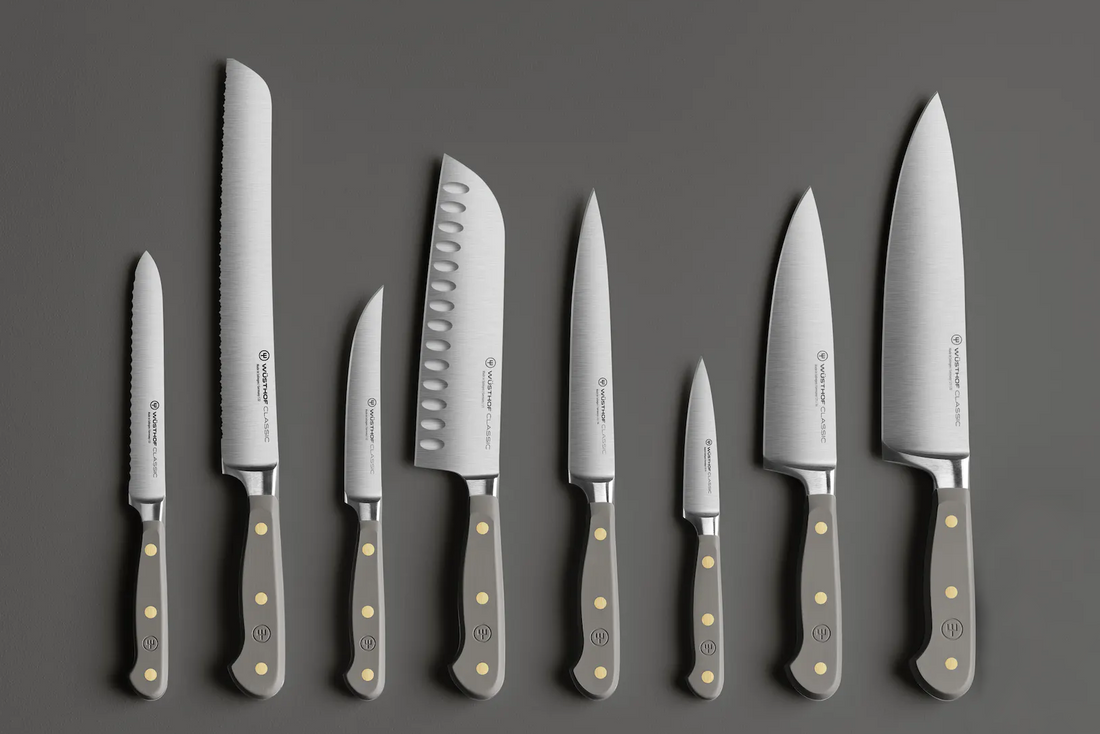Whether you’re a passionate home cook building out a knife set or someone just starting out in the kitchen with only a few knives, having the right tools is essential to creating delicious meals. Among those key items, perhaps none is more important than the right types of kitchen knives. Finding the perfect kitchen knife isn't always easy - there are so many different types of knives and sizes available. However, with some basic knowledge about knives and their uses, you can choose an efficient and dependable one that will last for years to come. In this post we’ll explore how to find the ideal knife that best suits your culinary needs.
Understanding the Types of Knives and Their Uses
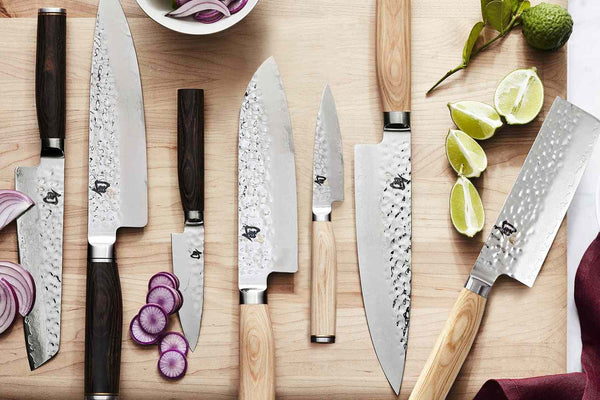
Basic Essential Knives for Any Kitchen

A chef knife, also known as a cook's knife, is a truly essential kitchen tool. Its razor-sharp blade makes it perfect for chopping herbs and vegetables, mincing garlic, dicing potatoes, and so much more.
[product=wusthof-classic-8-chefs-knife]
The Original chef's knife is iconic, withstanding the test of time, and maturing with quality and style. Unmatched in design and quality, the WÜSTHOF Classic 8" Chef's Knife is the all-rounder - perfect for mincing, chopping, or cutting meat, fish, fruit, and vegetables.
[/product]

A paring knife has a shorter blade than a chef’s knife, making it easier to use in tight spaces. It is ideal for any trimming jobs that may require precision such as the hulling of strawberries or peeling apples. Paring knives are also great for coring tomatoes, slicing citrus fruits, and cutting out small circles from vegetables.
[product=victorinox-little-red-knife]
No matter what you're about to prepare, the Paring Knife will help you do it. Small, sharp and agile, this knife is delicate enough for delicacies and tough enough for the toughest meats. Keep it close at hand and cut, slice and carve your way through to a beautiful meal every time.
[/product]

Finally, the all-purpose serrated or bread knife can handle any tough slicing tasks like cutting through a crusty baguette or other soft skin fruits and vegetables. It has long serrated edges and can be used for slicing bread, slicing tomatoes without crushing them.
Bread knives also come in a variety of sizes and shapes, including a classic straight blade style, as well as serrated offset blades and more. With the right blade shape and size to fit your needs, you can easily slice through bread with ease and create perfect slices every time.
Bread knives are essential for any kitchen because they help ensure that all types of bread are cut evenly and efficiently. With the right bread knife, you can create delicious sandwiches, pizzas, and other baked goods that look as good as they taste. So don’t forget to add a bread knife to your collection of kitchen tools today! A bread knife makes a great addition to any kitchen and is an essential tool for making delicious meals.
[product=wusthof-ikon-9-double-serrated-bread-knife]
WÜSTHOF's precise, double-serrated edge makes a clear difference with this bread knife: in contrast with a single-serrated edge, this knife has serrations within the serrations, meaning that it remains sharp for longer, requires less pressure and is suitable for very precise, smooth cuts.
[/product]
By adding these different types of knives to any kitchen collection, cooks can make meals in less time while also enabling themselves to tackle any job no matter how big or small.
Determine Your Budget - How much are you willing to spend on a good quality kitchen knife set
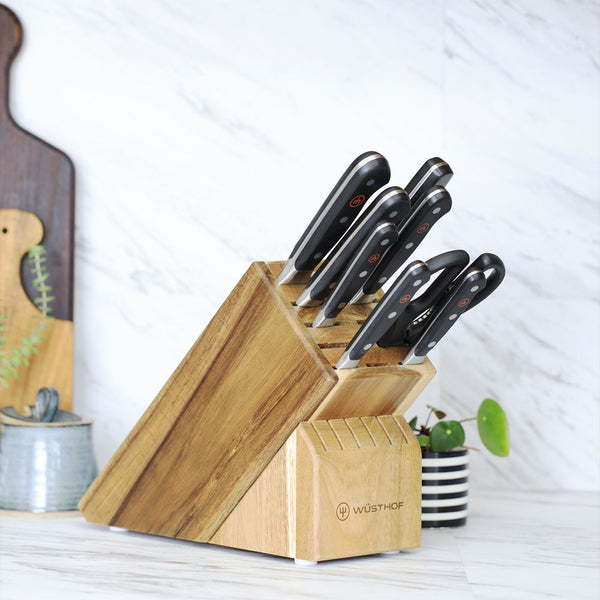
When investing in a good quality kitchen knife, knowing and understanding your budget is the first step to making smart purchases. Setting a finite amount can help ensure you get the most for your money – so don’t just search online for “kitchen knife sets” and start shopping!
Consider first how much you are willing to commit. If you’re making a substantial investment, you want to make sure that it fits within your budget and that it's something that adds value to your kitchen. A lot of our customers start with a Wusthof starter kit, which usually includes three knives, a honing steel, kitchen shears, and a knife block. This is a great place to start for many reasons– starter kits usually come at a significantly discounted price. Wusthof starter sets can be as much as a 30% discount compared to buying each piece individually. Because these sets come with the essential knives, you can add specialty knives over a longer period of time, allowing you to save up and buy a high priced-higher quality knife.

Do some research on what kitchen knife set will provide the type of knives you need with a comfortable grip and long-lasting materials to make sure you get what you need. Most people can prepare a full meal with just two to three types of knives. We always recommend starting with your core pieces which include the chef's knife, paring knife, and a utility or bread knife. From there, you can start to add your santoku or nakiri knives for vegetables, boning or filet knives for meats and fish, or even specialty blades like cleavers and butcher knives.
[product=wusthof-6-pc-ikon-starter-knife-set]
The series offers fully-forged blades that are incredibly sharp thanks to a unique sharpening process. Each blade features a striking double-bolster design, and the ergonomic handle rests perfectly in your hand for optimal performance and comfort.
[/product]
Consider the Material - What type of material do you want to use for your new knives (i.e., stainless steel, carbon steel, ceramic, etc.)
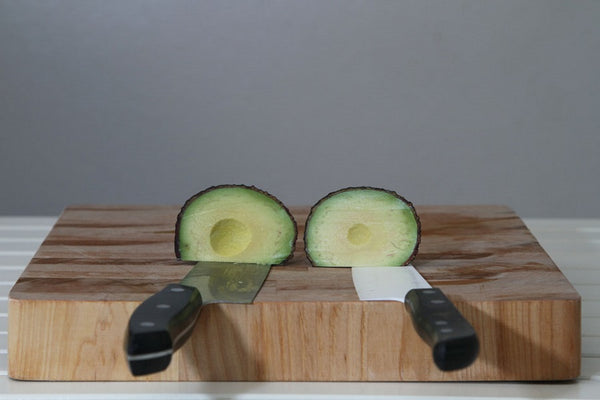
Customers looking to purchase a new set of knives should consider the different knife materials available and what best suits their individual needs. For example, stainless steel knives are durable, easy to care for and do not rust or corrode easily; however this material can dull more quickly than other materials such as carbon steel or ceramic. Many modern knives have intricate compositions that consist of high carbon and other desirable additions such as chromium, tungsten, molybdenum and vanadium - a menagerie of metals that when mixed together make for an incredibly fine-grained blade with exceptional sharpness, corrosion resistance strength while also increasing its impact tolerance.
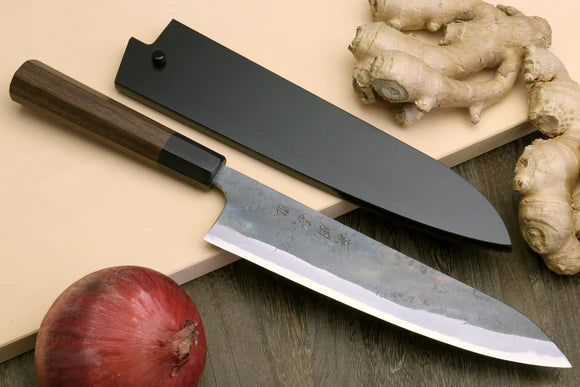
A carbon steel blade provide sharpness retention for a longer period but is at risk of rusting unless it is regularly oiled. When using carbon steel blades, it is especially important to clean and dry the knife immediately after using it. This will prevent any build up and minimize the amount of time the metal is exposed to moisture that could cause rust.

Ceramic knives stay sharper for longer, however they're also brittle and delicate so careful consideration must be given when using them on hard surfaces. Ceramic knives cannot be sharpened through normal sharpening methods and often must be replaced entirely if the blade loses its edge. Ceramic knives are also prone to shattering if dropped- while a metal knife may develop a knick or lose the tip, they will never break into pieces the way ceramic knives can.
At Browns Kitchen, we offer contains a variety of knives and knife sets utilizing different materials that are dependable and durable; our knowledgeable staff can help customers find the perfect knife tailored to their individual needs.
Forged Knives Versus Stamped Knives
Each type has its own set of benefits, so it’s important to understand the differences between these types of kitchen knives in order to make an informed decision when purchasing.
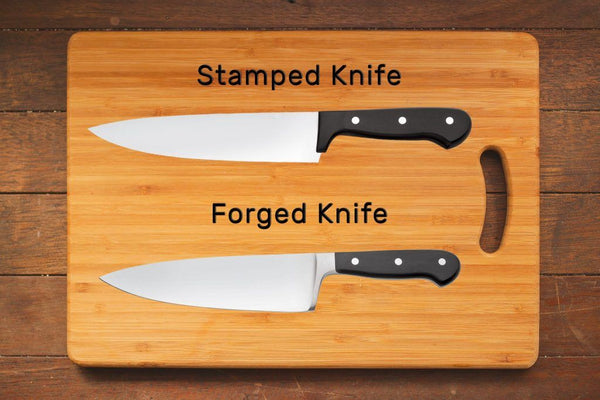
Forged knives have been heated and hammered into shape which makes them stronger and more durable than stamped knives which are simply cut out of metal sheets using molds.
Furthermore, forged blades tend to be heavier and can be sharper than their stamped counterparts due to precision grinding during production. In addition, they often feature a full tang design for good balance as well as a comfortable handle design for ease of use.
One benefit of stamped blades over forged knives is that a stamped blade is usually more flexible. This could be a positive benefit when considering what type of boning or filet knife to add to your collection.
Think About Comfort - Which kitchen knife handle design and weight is best suited for you
Choosing a kitchen knife handle design and weight is an important part of creating a comfortable kitchen experience. If you're unsure which option is best for you, understanding the purpose of certain designs can help narrow down the options. Ergonomic handles are usually designed for improved comfort and grip, while wooden handles are often more aesthetically pleasing and lightweight.
Knives with heavier designs can prevent fatigue from extended use, while lighter knives provide more maneuverability. Finding the balance between comfort and performance is key, so try out different types of handles in the store to decide what works for you before making your purchase!
Research reputable brands that specialize in kitchen knives

Stocking your kitchen with reliable and effective knives is essential for any aspiring home cook. Fortunately, there are many reputable brands that specialize in kitchen knives, and while the choices can seem overwhelming at first, our research has led to four excellent names: Shun, Wusthof, Zwilling's Miyabi Kaizen II, and Victorinox.

Shun Knives are renowned for their exceptional quality, blending traditional Japanese craftsmanship with cutting-edge technology. Each knife is a testament to meticulous attention to detail, resulting in blades that offer unparalleled sharpness, precision, and durability. With a diverse range of blade styles available, Shun ensures that there is an option tailored to meet the unique needs and preferences of every chef, from versatile multipurpose knives to specialized blades designed for specific tasks. This commitment to variety and excellence makes Shun Knives a favorite among culinary professionals and home cooks alike, elevating the art of cooking with every slice and chop.

Similarly, Wusthof cutlery stands as a beacon of excellence, honed and perfected over a rich history spanning more than 200 years, resulting in an impeccably sharp cutting edge that consistently delivers precision cuts. These knives are the reliable workhorses of any kitchen, trusted by chefs and home cooks alike for their outstanding performance. One of their key attributes is their ability to maintain their sharpness even after prolonged use, making them ideal companions for demanding culinary tasks that require extended hours in the kitchen. Wusthof knives embody a legacy of craftsmanship and quality, making them a timeless choice for those who value exceptional performance and durability in their cutlery.

The Miyabi Knife collection seamlessly blends traditional Japanese craftsmanship with modern engineering and design, embodying the best of both worlds. Handcrafted in Seki, Japan, a renowned hub for blade-making excellence, each knife undergoes meticulous craftsmanship to ensure unparalleled quality. One of its standout features is the double ice-hardened blade, which not only provides exceptional sharpness but also enhances corrosion resistance, promising longevity and durability. Complementing its performance is the comfortable D-shaped handle made from black pakkawood, offering a secure grip and ergonomic support for precise and effortless cutting.

Victorinox knives, rooted in a legacy dating back to the creation of the Swiss Army Knife in 1884, embody a mindset of preparedness and excellence. Swiss made and trusted by professionals, each Victorinox knife is crafted with meticulous precision and top-quality materials, ensuring sharpness and durability that simplify meal preparation and elevate culinary outcomes. With Victorinox, the pursuit of culinary excellence becomes effortless, allowing you to create unforgettable meals with ease.
Check out these prestigious brands in the store today!
Look at the Maintenance Requirements - How easy is it to clean and maintain your new kitchen knives
Keeping your kitchen knives in top condition is key to ensuring a long-lasting, quality product. Regular maintenance of your kitchen knives helps ensure that they are always clean with the blade sharp, no matter the task.
Proper Cleaning
When it comes to cleaning and maintaining your new kitchen knives, take a few simple steps to make sure you get maximum use out of them and keep them in great condition. Our favorite cleaning brush for our knives is the Joseph Joseph Blade Cleaning Brush! It's dual sided brush makes it safer and easier to scrub residue off of your blades!
Always wash your kitchen knives by hand in warm water with mild dish soap and dry them immediately. Wipe away any food remnants after each use – this can help prevent rust spots. Be sure not to leave your knives in the sink or submerged in water as this can lead to rust!
[product=blade-brush-knife-cleaner]
Cleaning sharp knives and cutlery can be a hazardous task, but with this innovative washing-up brush it’s much safer.
[/product]
Knife Storage
We suggest storing your knives in a knife block, drawer storage insert or with a blade cover on to maintain a sharp edge. Not only does this protect the edge of your blade, it also protects you from accidentally injuring yourself on an exposed blade. With these simple steps, you’ll be able to protect your blade and enjoy the highest quality product for many years to come!
Choosing which style of knife storage you want to use is a personal choice. Love to display your collection for others to see? Go with a block that will keep them neatly organized on your countertop. Lacking prep space? Move your knives into a drawer with a drawer organizer or blade covers to free up counter space! All three options are customizable to fit a wide range of knife sizes and styles.
[product=wusthof-14-slot-in-drawer-knife-organizer]
This in-drawer knife tray is an ideal way to safely store your cutlery without taking up valuable counter space. The WÜSTHOF Large In-Drawer Knife Tray is made of beech wood and can hold up to 14 knives.
[/product]
How Often Should You Sharpen Your Knives?
Most experts recommend sharpening your kitchen knives every 6-12 months, depending on how frequently you use them. If you cook every day, then you should sharpen your knives more often than someone who only cooks a few times a week. You can tell when your knives need sharpening by looking at the blade. If it's dull and has difficulty cutting through food, it's time to sharpen them. An easy test we like to do is the paper test– hold up a piece of printer paper and try to slice through it with your knife. If you have a clean cut, your knife is sharp and ready to cook! If your paper tears, rather than a smooth cut, it's a sign that it's time to sharpen that knife!

Honing Vs. Sharpening
Keeping your blades in great condition isn’t as difficult you might think. Honing is a process of realigning the existing edge on a knife and should be done regularly, while sharpening creates an entirely new one - which only needs to happen every 6-12 months.

Regularly honing your knives is essential to maintain their sharpness and prolong their lifespan. Honing helps realign the blade's edge, ensuring it remains straight and sharp for efficient cutting. To hone your knives, start by holding the honing steel vertically with the tip resting on a stable surface. With the blade's heel against the steel, angle the knife at about 15-20 degrees and draw it downward and across the steel in a sweeping motion, from the heel to the tip, ensuring even contact along the entire edge. Repeat this process on both sides of the blade, alternating between each side several times until the blade feels sharp and aligned. Regular honing, preferably before each use or at least weekly for frequently used knives, will help keep your knives in top condition for smooth, precise cutting.
When it comes time to sharpen them up again grab either specialized tools like whetstones or take ‘em into the professionals! Browns Kitchen sharpens knives in-house, meaning you don't have to wait weeks for shipping! And at just 75¢ per inch of the blade, it is a super affordable way to maintain your knives quality!
Professional Sharpening vs. DIY Sharpening
Many people wonder whether they need to have their kitchen knives professionally sharpened or if they can just sharpen them at home to maintain a very sharp edge. After prolonged use of your knife, the cutting edge angle becomes progressively blunter. Eventually it will reach a point where only regrinding on professional machinery can do justice . When this is the case, don’t hesitate to bring your knives in to Browns Kitchen. We use a professional grinding machine that will bring back that razor-sharp slicing experience you know and love! Call Browns Kitchen for details.
Chef's Knife or Santoku Knife?

Both chef’s and santoku knives are multipurpose kitchen knives designed for breaking down food and chopping. The main difference between a chef's knife and santoku knife is the shape of their blades. A traditional chef’s knife has a rounded blade, while a santoku knife, which originated in Japan, features a straight edge. Another key difference lies in their length - the blade of a santoku is usually between 5-7 inches long, while the blade of its counterpart can range from 8-10 inches. Deciding which works best for you comes down to your personal preference.
In terms of similarities, both chef’s and santoku's have broad blades that allow them to mince herbs or cut larger items like squash without having to pre-chop into smaller pieces. They are also designed to handle multiple tasks such as dicing onions, mincing garlic, slicing cheeses, julienning carrots, disjointing chickens etc., making them excellent all around workhorses in the kitchen.
Chef's Knives are designed to be rocked forward during cuts, whereas Santoku knives feature a flat tip that allows users to slice in one quick motion - providing speed and efficiency with every cut. Additionally, single-beveled Santoku knives have sharper blades due to their ability of having angles sharpened up as low as 15 degrees on only one side!
Do I need a Nakiri Knife Then?

A Nakiri knife is a Japanese-style vegetable knife. It has a rectangular shaped blade that allows for fast, clean cuts of vegetables and fruits. The rectangular blade shape and design make Nakiri knives perfect for chopping large pieces of produce into small uniform cubes or strips. Its thin, sharp edge can also be used to cut meats or fish with precision and ease. Additionally, its lightweight construction makes it ideal for performing slicing tasks quickly and smoothly.
Paring Knife Versus Utility Knife

When it comes to choosing between a paring knife and a utility knife, the choice really depends on the task at hand. A paring knife is a small, lightweight blade with a pointed tip that is great for precision work. It is ideal for tasks like peeling, trimming and slicing small fruits and vegetables. A utility knife, on the other hand, is a medium-sized knife with a serrated or straight edge. The blade is generally longer than a paring knife and narrower than a chef's knife with it's more typical thick blade. Utility knives are versatile and can be used for a range of tasks such as slicing bread or meats, filleting fish, and chopping up large vegetables. While a paring knife may be more suitable for intricate tasks like deveining shrimp or hulling strawberries, a utility knife's larger size and sometimes serrated edge makes it better for tasks like slicing through crusty bread or carving medium-sized roasts. Ultimately, both knives have their unique features and uses, and it's up to the individual cook to choose the right one for the job.
Boning knife vs Carving Knife vs Fillet Knife
A boning knife and a carving knife are both essential tools in the kitchen, but they serve vastly different purposes. Boning knives are designed to remove small pieces of meat from larger cuts. It has a thin, flexible blade that allows it to move between bones and joints efficiently while still providing enough stability for precision cutting. The blade also has a sharp point that can be used to accurately trim fat or tendons.
carving knife, on the other hand, is designed for slicing cooked meats into thin, even portions. It features a long, thin blade with either a slightly curved blade or straight edge and is usually larger than a boning knife. The blade design allows it to easily and accurately slice through large pieces of meat with minimal effort.
The boning knife is used to cut through meat and bones while the carving knife is ideal for slicing up larger pieces of meat. Lastly, the fillet knife is perfect for delicately cutting thin slices of fish or meat. We'll discuss how to differentiate each type of knife, when to use them and tips on proper handling and storage.
When selecting a knife, look for one that has an ergonomic handle and is made of high-quality materials. A boning knife should have a narrow, flexible blade with sharp edges to help you get through tough joints. The carving knife needs to be thin and razor-sharp so that it can easily slice through meat. Lastly, the fillet knife should have a thin, flexible blade that allows for delicate cutting.
The importance of Table Knives and Steak Knives
These two types of knives serve different purposes and it’s important to understand their differences in order to select the best ones for your needs.
A table knife, or dinner knife, is commonly used at the dinner table as the name suggests It is not as sharp or heavy-duty as a steak knife. A table knife typically has a blunt, rounded tip that helps you spread butter or cut soft foods such as cheese and vegetables. They also usually have a serrated edge that helps to saw through thin slices of meat and poultry.
A steak knife is made with a much sharper, pointed tip that assists in cutting through tough proteins such as steak, poultry and pork. This tool is designed to easily cut through thicker pieces of meat without tearing the flesh. Contrary to popular belief, serrated steak knives can mangle and tear meat beyond repair. Smooth-edged blades not only do these give a cleaner cut on steaks, but can also be sharpened over time for extended use.
What about cheese?

Cheese aficionados know that a good cheese knife is just as important as the cheese itself. Not only do cheese knives make slicing cheese breeze, but they also help preserve the delicate flavors and textures of your favorite cheese varieties. But with so many options to choose from, how do you know what to look for when buying a cheese knife? Here are some important things to consider:
Types of Cheese Knives
The first thing to know is that there are several different types of cheese knives. Each type is designed with a specific cheese variety in mind, so it's important to choose the right knife for the cheese you'll be serving. Here are some popular types of cheese knives:
Soft Cheese Knife
Designed for soft cheese varieties like brie and camembert, which can be tricky to cut with a regular knife. Soft cheese knives usually have holes in the blade to prevent sticking.
Hard Cheese Knife
Designed for harder cheeses like cheddar and Parmesan, which require a sharp, sturdy blade for slicing through their dense texture.
Cheese Plane
Also called a cheese slicer, a cheese plane is a simple tool with a flat blade that glides over the surface of cheese, creating thin slices.
Cheese Fork
A cheese fork is a multi-purpose tool that can be used for both serving and cutting cheese. It usually has a sharp pronged tip for piercing and holding the cheese in place while cutting.
Kitchen Shears? Can't I Just Use Scissors?
Unlike scissors, kitchen shears have a variety of features that make them more suitable for cutting through food. Kitchen shears have blades that are thicker and more durable than standard scissors, allowing you to easily cut through thick fruits and vegetables, as well as chicken bones or other tough items. The handles are designed to be ergonomic, so they provide comfortable grip while protecting your hands from sharp edges.
Additionally, there are usually micro-serrations along the blade, which help to grip food items and prevent them from slipping while cutting. This also helps to create a cleaner cut by preventing food items from being squashed or torn when using scissors. Some kitchen shears even have built-in bottle openers, nutcrackers, and other features that can be incredibly handy in the kitchen.
From a Paring Knife to a Chef's Knife - In Conclusion
All in all, choosing the right types of kitchen knives are essential to the success of your cooking. With so many types of kitchen knives out there, it can be difficult to decide which ones to get. Consider your budget, the material, comfort, maintenance requirements and brand before making a decision. Investing in quality kitchen knives is a worthwhile endeavor that will last for a long time, so choose something you know you'll enjoy using and won't regret down the line. Ultimately, picking the best knife set for yourself comes down to personal preference and what works best for your needs - at Brown's Kitchen, you’ll end up with some great new knives that will make food preparation easier and more enjoyable while allowing you to sharpen your knife skills!

